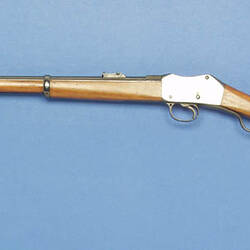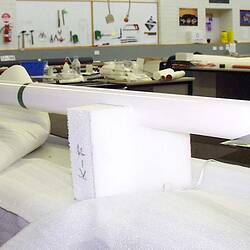Moves for the colony of Victoria to become self reliant in terms of arms and ammunition production had first arisen around the middle of the nineteenth century when various assumed threats - namely the Russians, and later French - were at their peak. The withdrawal of the last British Imperial troops from Australia in 1870 only exaggerated a feeling of insecurity in terms of defence that had been building throughout the decade preceding their departure, a decade which saw the rapid rise of the Colony's volunteer forces.
By the mid 1880s the topic of the 'Manufacture of Ammunition, Powder, & c., in the Colonies' was appearing regularly in the local newspapers and was making advances at a political level. Prompted by the frequent media reports on the subject, the Victorian government began to receive offers for the establishing of factories based on the English models. Alexander Davidson, whose father had previously worked for ten years in a senior role with the British Government Shell Factory at Woolwich wrote that his father was 'prepared to come and superintend the fitting up of a factory for the manufacture of small-arms, ammunition, gun-powder, gun-cotton, torpedoes, and all other warlike material, and also the manufacture of it'.
Britain's inability to adequately support colonial defence was looked on by some within the Colony with contempt: 'Under the present aspect of affairs it is not likely to be very long before the Imperial Government, in preparation for one of its numerous little wars, or to be in readiness for what may occur in Europe, may be drawing so heavily upon the powers of production in England, that the colonial orders will be put aside temporarily'. However, if Victoria could establish its own source of production locally, the Secretary of Defence wrote in December 1886, 'The [other Australian] colonies will then be only too glad to replenish their supplies from the nearest source available'. South Australia confirmed 'that this Government will be willing to obtain its gunpowder supplies at a fair rate from any Victorian factory'.
By late 1886 the Government had determined its position. 'It is not the intention of the Government to establish a Government factory, but rather to trust to private enterprise, and it is expected that before long this manufacture will be undertaken by a private company'. Financial incentives were floated to encourage private contracts, with the Government offering a bonus of two thousand five hundred pounds 'to the first factory of the kind established in the colony', the promise of a free grant of land, and - providing quality matched that currently obtainable from England - figures of between two and three million solid-drawn rifle cartridges would be required by the Department of Defence. 'All Government supplies would be procured from the factory', the Secretary of Defence assured one applicant.
Realisation of the project came in 1888 when Captain Whitney established the Colonial Ammunition Factory in Footscray.
Subsequent additions were made across the inner western suburbs in 1908 with the opening of the Commonwealth Explosives factory at Maribyrnong and the Commonwealth Ordnance factory following the First World War. At its peak during the early 1940s more than 8000 workers were employed in the manufacture of ammunition and related explosives, providing thousands of jobs for western suburb workers for more than a century.
The Colonial Ammunition Factory site was finally redeveloped, being replaced by the Edgewater housing estate in 2001.
References:
'Arsenal and Small-Arms Factory: A copy of all expert's reports, letters, and other papers in connection with the establishment of an arsenal and small-arms factory in Australia', Victorian Parliamentary Papers, 1888, vol. 1, C.18.
Thomas, Benjamin (2002). Up in Arms: A History of the State Arms Collection, 1856-1900, unpublished BA Hons thesis, School of Fine Arts, Classical Studies and Archaeology, University of Melbourne.
More Information
-
Keywords
-
Authors
-
Article types



